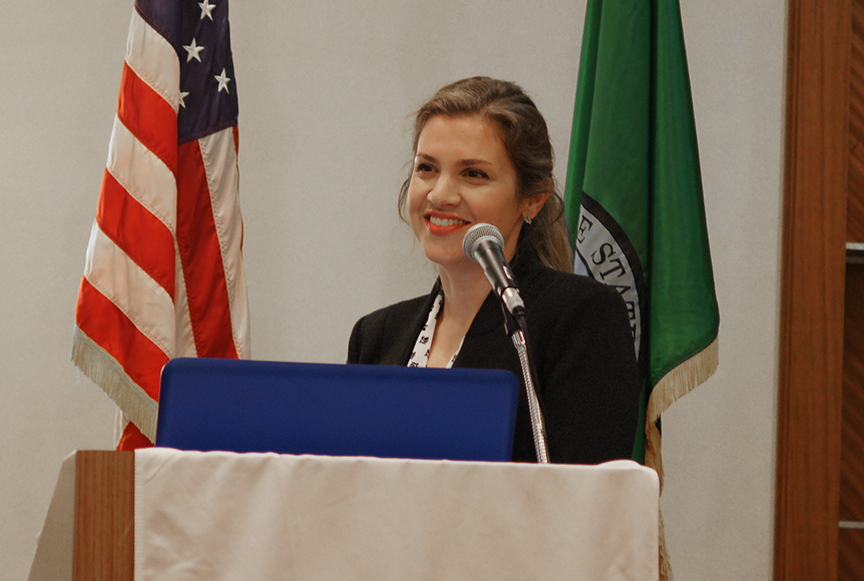Dr. Cartwright earns runner-up finish in 2017 ICS research competition
Dr. Tessa Cartwright, chief fellow in the University of Kentucky’s division of Cardiothoracic Surgery, took second place honors in the 2017 Research Scholarship Competition sponsored by the International College of Surgeons – US Section (ICS-US) on Saturday, June 17 in Seattle.
The competition was one of several events held during the ICS-US’ Annual Surgical Update over the weekend.
The competition invited submissions of original clinical research papers from medical students, residents, and fellows in general surgery and all surgical subspecialties. Competing research papers were first scored and judged by the ICS-US Section Scholarship Committee several months prior to the annual conference. Top finishers were subsequently invited to make an oral presentation before a panel of judges.
The title of Dr. Cartwright’s presentation, Esophageal Stents: a Single-Center Retrospective Review of Surgical Experience, tracked and analyzed the use of such stents at the University of Kentucky A.B. Chandler Hospital from January 2000 through December 2014. The oral presentation consisted of a brief summary followed by a question and answer period.
The abstract of Dr. Cartwright’s presentation is included below.
Esophageal Stents: a Single-Center Retrospective Review of Surgical Experience
Methods: We undertook a retrospective analysis of the electronic medical records from our University Cardiothoracic Surgery Division to evaluate the experience of esophageal stent placements using codes 43219 and 43212 between January 2000 to December 2014. A review of the literature was also performed. Data was analyzed using SPSS statistical software v. 23 (IBM Corp., Armonk, NY). Results: One hundred procedures were identified for 56 patients, including two pediatric patients receiving 11 stent procedures for TEF. Twenty-five patients had two or more consecutive procedures. The median age at time of procedure was 57.5 years (range 2.6-85) and almost two-thirds of procedures were performed in males (36/56, Table 1). Sixty-four percent of patients had a history of esophageal or lung cancer. Indications for the 100 surgeries included fistula (30%), dysphagia (25%), perforation (23%), stricture (15%) and leak (7%). Stents included 20 proximal, 24 middle and 56 distal esophagus placements. Morbidities included 24 stent migrations, 2 displacements, 2 obstructions, 8 esophageal leaks, 4 fistulas, and one each of pneumonia, airway compression, dysphagia, and hemoptysis (Table 2). A statistically significantly greater stent migration complication was noted for stents placed proximally (55%) as compared with distal (19.6%) and middle (8.3%) (p<0.01). The morbidity rate for benign indication was 48% versus 41% for malignant indication (p = .548). Among procedures performed on adults only (N=89), the morbidity rate for benign indication was 64.5% versus 41.4% for malignant indication (p = .047). Of the 56 patients, 12 were lost to follow-up such that their mortality status is unknown. In the remaining 44 patients 30 (68%) died at a median 107 days (range 2-2383) after their first or only stent placement. Known mortality was 90% (26/29) in malignant indications vs. 27% (4/13) for benign indications (p < .001). 30-day death only occurred in the malignant group (7/29, 24%). Of the 54 patients, 12 were lost to follow-up such that their mortality status is unknown. In the remaining 42 patients 30 (71%) died at a median 107 days (range 2-2383) after their first or only stent placement. Mortality was 72% (26/29) in malignant indications vs. 22% (4/13) for benign indications (p = .001). 30-day death only occurred in the malignant group (7/29, 24%). Conclusions: Esophageal Stents are commonly used for palliation and for contained leaks. Perioperative mortality is low for benign indications; however, the morbidity rate was significantly higher for those with benign indications as compared to malignant. The overall mortality was significantly higher for malignant indications as compared to benign. The most common indication for stent placement was fistula followed by dysphagia, perforation, stricture and leak. A statistically significantly greater stent migration complication was noted for stents placed proximally (55%) as compared with distal (19.6%) and middle (8.3%). Lastly, we did not find a statistically significant difference in complication stent placed for benign as compared with a malignant etiology. |
